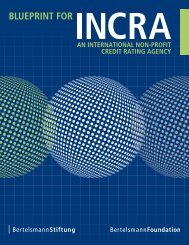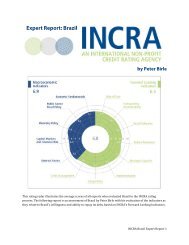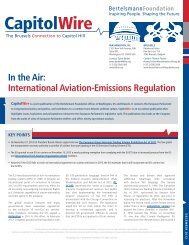means to achieve it (the so-called “3 Ms”of providing better access to money,European markets and mobility to theregion) and a methodology (“more formore”, or a more serious attempt atenforcing conditionality when providingaid). 23 A later joint communication 24in May 2011 outlined the results of theENP review, and promised an additional€1.2 billion of funding, on top of €5.7billion already budgeted, for the 2011–2013 period. 25 Looking ahead, the EU willcontinue to rely on an expanded ENP asits main tool to support the process oftransition in the Middle East and NorthAfrica. The ENP’s budget is slated toreach €18.2 billion for the 2014–2020period, or a 40 percent rise from theamount available for 2007–2013. 26Recommendations for 2013Both Europe and the US care aboutthe Middle East and North Africa,but the US has more vital interests inthe Middle East whereas Europe hashigher stakes in the future of NorthAfrica. Both allies agree that economicand political progress are interrelatedwhen it comes to democratization inthe Arab world, but Washington putsmore stress on economic developmentas opposed to Brussels’ commitmentto political reform. 27 Europe tendsto favor government-to-governmentcooperation, while the US is morewilling to work directly with civil societyorganizations. But these divergencescan be an opportunity, rather thana challenge. By working togetherEurope and the US can offer betterlong-term policies towards the Arabtransition precisely because they havecomplementary, rather than identical,approaches. Building on existingcooperation, especially at the groundlevel, by exchanging best practices andexpertise, Europe and the US can avoidunnecessary duplication and offer awider toolkit of approaches to their Arabpartners.1. Promote regional integration,starting with North Africa:The autocratic regimes that dominatedNorth Africa helped to create closedIn Millions of USD (2009-2010)450400350300250200150100500Algeria Egypt Jordan Libya Morocco TunisiaUnited StatesFrancesocieties, with often very negativeeconomic and political consequences.The trans-Atlantic partners can helpundo that legacy by promoting widerregional integration, with the EU takingthe lead because of its existing tieswith the region. The US should activelysupport Brussels’ efforts to establishcloser cooperation between NorthAfrican states. Doing so will providemuch-needed help to revitalize andexpand intra-North African trade, andwith a clear focus on projects that wouldinvolve multinational cooperation.Official Development AssistanceTrade with the EU 27(% of total trade)Source: OECD, foreignassistance.govEU InstitutionsGermanyMoreover, the US should encourage theEU to redefine its trade relations withNorth Africa in a way that further benefitsthe latter’s development. In particular,the US can push the EU to open up itsagricultural market to North Africanproducts and increase investments inareas, such as solar energy, that couldhelp create jobs. Washington can alsosuggest that Brussels extend its widercustoms union with Turkey to countriesalong the southern Mediterranean coast,which would help to boost intra-regionaltrade in North Africa. 282010 Trade with North African StatesTrade with the US(% of total trade)Trade with the restof North Africa(% of total trade)Algeria 50% 16.5% 2.7%Egypt 31.9% 8.2% 3.9%Libya 64.9% 4.2% 5.4%Morocco 53.1% 6% 3.8%Tunisia 69.7% 2.6% 8.4%Source: European Commission Trade Statistics, 20103 4The Arab Uprising
2. Strengthen regionalpartnerships to provide a betterframework for peaceful change:US and European efforts to promotedemocratization in the Arab world, as wellas to safeguard existing achievements,are more likely to be successful ifthey fully involve regional actors andinstitutions. To that end, Europe andthe US should focus on establishingcloser cooperation with Turkey and theGulf Cooperation Council (GCC)—thepolitical and economic union betweenBahrain, Kuwait, Oman, Qatar, SaudiArabia, and the United Arab Emirates. 29Turkey and the GCC, aside from theirfinancial clout, share the European andAmerican objective of creating a morestable and peaceful framework for theprocess of internal change in the Arabworld. Turkey, in particular, would be avaluable asset because of its relativepopularity among the Arab public andits successful recent model of economicreform 30 ; having the GCC states on boardcould make it easier for the US andEurope to encourage domestic reform inthose states without alienating them.4. Develop a long-term strategytowards the Middle East and NorthAfrica, but stay away from a“one-size-fits-all” approach:Through close consultation, the US andthe EU need to rethink their overallapproach towards the Middle East andNorth Africa. Europe (with the revisedENP) and the US eventually made somemuch needed policy adjustments inresponse to the Arab uprising, but in thelong term this cannot be a substitutefor developing a broader, more lastingpolitical strategy to accompany theprocess of reform in the Arab world. 31Europe and the US should steer awayfrom models such as the ENP, whichtries to offer an overarching frameworkto address the diversity of situationsacross the Arab region. Instead, the EUand the US should aim in tandem todevelop specific responses tailored forthe sub-regions of the Arab world—onethat works for the Maghreb (Morocco,Algeria, Tunisia, Libya and Mauritania)and Egypt, and one dedicated to theMashriq (Iraq, Palestine, Jordan, Kuwait,Lebanon and Syria). 32The EU and the US shouldaim in tandem to developspecific responses tailoredfor the sub-regions of theArab world—one thatworks for the Maghreb(Morocco, Algeria, Tunisia,Libya and Mauritania) andEgypt, and one dedicatedto the Mashriq (Iraq,Palestine, Jordan, Kuwait,Lebanon and Syria).struggle for influence among autocrats,democrats and theocrats. Moreover, civilsociety organizations are weaker in theMiddle East and North Africa than theywere in socialist Europe and the Arabstates also lack the positive catalyst forchange created by the prospect of EU/NATO membership. 33 These differencesnotwithstanding, Europe and the US canstill draw important lessons from thepost-Communist transitions in Europethat could apply to the Arab world.3. Decouple the Middle East peaceprocess from the Arab uprising:The Arab-Israeli conflict remains avery significant source of tension, inparticular within the Arab world. Thefate of the Palestinians resonates deeplywith other Arabs, and it is a powerfulemotional card that governments oftenplay. Injecting renewed momentuminto the peace process is an essentialobjective for Europe and the US, but itis one that needs to be kept separatefrom the Arab uprising. Solving the longenduringArab-Israeli conflict could havemajor repercussions for the securityand stability of the Arab world, but it isunlikely to facilitate democratization inthe region or help its people find jobs.The process of reform in the Arab worldwill be hard enough on its own, andtying it to the peace process would onlybe counterproductive.5. Rely on the expertise drawnfrom Eastern and Central Europe’spost-Communist transitions:The Middle East and North Africa in 2012are certainly not in an identical situationto that of Eastern and Central Europeafter 1989. The political fault linesdiffer, with the Arab world undergoing aEurope and the US can support in-depthstructural reforms, anti-corruptioninitiatives and judicial reform. Theycan help by striving to develop theprivate sector, with a strong focuson small businesses, by encouraginglocal governments to reduce excessivebureaucracy and subsidies, and bypromoting efficient rather than rapidEuropean Neighborhood Policy (ENP) (2007–2013)ENP aid 2007–2010(per annum, in millions of €)Algeria 55 57.33Egypt 139.8 149.76Libya 2 20Morocco 163.5 193.5Tunisia 75 130ENP aid 2011–2013(per annum, in millions of €)Source: European Commission, European Neighborhood Info CentreThe Arab Uprising3 5
- Page 3: Field Manual to EuropeIntroduction
- Page 6: multilateral channels. Europeanshav
- Page 9 and 10: JuneBritish presidency of UNSCJune
- Page 12 and 13: US-EU Investment vs. Global Nationa
- Page 14 and 15: economic conditions in the eurozone
- Page 17 and 18: MEMO ONTHE EUROZONE CRISISThe State
- Page 19 and 20: attitude toward moral hazard. Withw
- Page 21 and 22: Greece: 2010 Bailout BreakdownGreec
- Page 23 and 24: the deficit from 4.5 percent to thr
- Page 27 and 28: NATO thus faces an uncertain future
- Page 29 and 30: 1. Consider NATO’s defensespendin
- Page 31 and 32: of-area operations and worldwidepar
- Page 33: concurrent terrorist attack in Beng
- Page 38 and 39: MEMO ONCOUNTERTERRORISM ANDHOMELAND
- Page 40 and 41: home affairs (JHA), particularly in
- Page 43 and 44: Status of EU Countries in the US Vi
- Page 45 and 46: offensive capability centered at NA
- Page 47 and 48: socialized, i.e. there is a tacit e
- Page 49 and 50: such technology, such as deep packe
- Page 51 and 52: MEMO ONENERGY & CLIMATE CHANGEThe S
- Page 54 and 55: identifying the agents most qualifi
- Page 56 and 57: MEMO ONTURKEYThe State of PlayTurke
- Page 58 and 59: as a rising regional and internatio
- Page 60 and 61: CASE STUDY: TURKEY’S ENERGY ROLE:
- Page 62 and 63: 22%12%Turkey’s Main Trading Partn
- Page 64 and 65: MEMO ONRUSSIAThe State of PlayIn Pr
- Page 66 and 67: EU-Russia security apparatus. Themo
- Page 68 and 69: greater market access for US busine
- Page 70 and 71: MEMO ONCHINAThe State of PlayIn 201
- Page 72 and 73: But China’s competitive meridian
- Page 74 and 75: in millions of USDUS-China Bilatera
- Page 76 and 77: 7 6Acknowledgements
- Page 78 and 79: CITATIONSINTRODUCTION1See “Confid
- Page 80 and 81: 20Castle, S. (17 September, 2011).
- Page 82 and 83: ARAB UPRISING1Koch, C. (summer 2011
- Page 84 and 85:
COUNTERTERRORISM & HOMELAND SECURIT
- Page 86 and 87:
21Healey, J. (January 2012). Beyond
- Page 88 and 89:
20Berlemont, I. (25 July, 2012). Fr
- Page 90 and 91:
24Putin, V. (6 September, 2012). An
- Page 92:
Bertelsmann Foundation1101 New York






